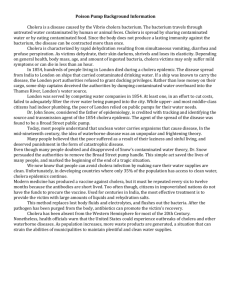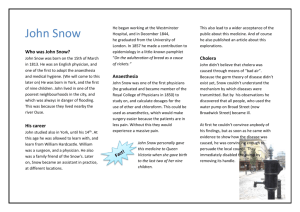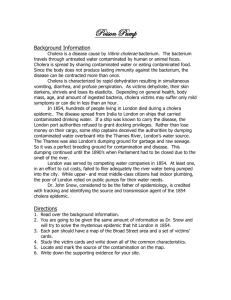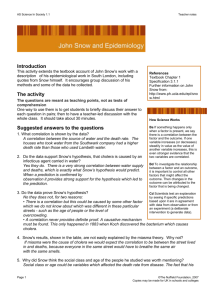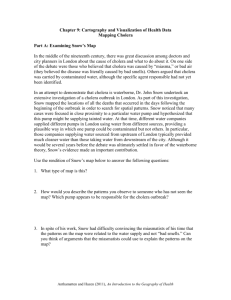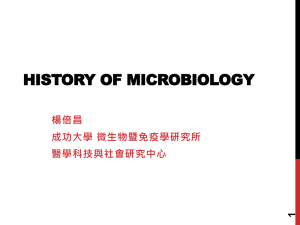Epidemic Diseases of the 19th Century
advertisement
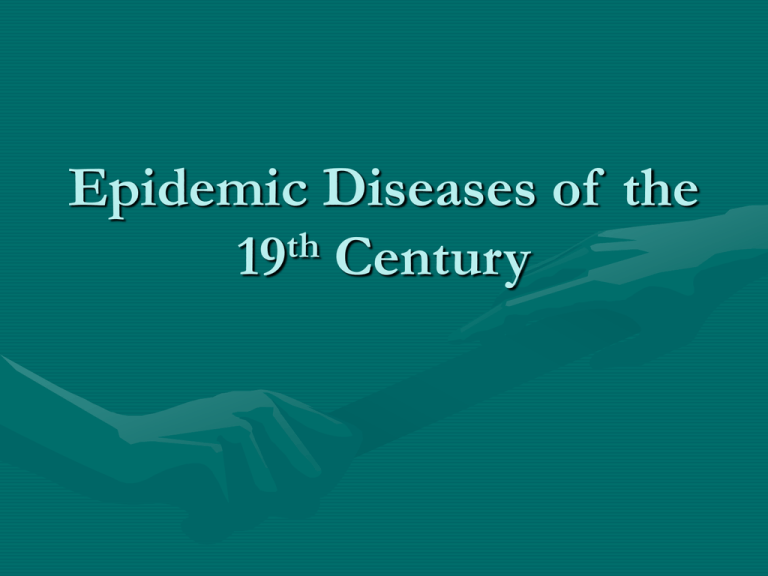
Epidemic Diseases of the th 19 Century The Demographic Context • 19th century experienced explosion of endemic & epidemic diseases • Related to: – – – – Industrialization Urbanization Trade activities Military activities • Factors were similar to the Middle Ages • Scale of these changes exponentially greater • Britain first country to experience industrialization • Associated with: – Significant population growth – Significant migration to urban centres • Explosive growth of cities outstripped their infrastructures – Water supply – Sewage – Housing • Manchester is an example Population Growth in Manchester 350,000 300,000 250,000 200,000 150,000 100,000 50,000 0 1717 1758 1773 1801 1821 1831 1841 1851 • Northern industrial cities such as Manchester & Liverpool grew faster than London • Result was horrific living conditions for the working class • Subject of many studies – Chadwick: Report on the Sanitary Conditions . . .(1842) – Engles: Condition of the Working Class . . .(1844) – Mearns: Bitter Cry of Outcast London . . .(1883) • Emergence of statistics helped Britons “see” the impact of urbanization • William Farr – Prominent epidemiologist – 2nd Registrar General of the Central Board of Health – Instituted systematic collection of vital statistics – Developed many statistical methods still in use today • Farr’s 1843 Report concluded that urban life expectancy was lower than rural life expectancy – Average national life expectancy: 41 years • Rural Surrey: 46 years • London: 36.7 years • Liverpool: 25.7 years – Highest mortality in children under age 5 • ½ of all children in Liverpool dead by 5th birthday • In Surrey, ½ dead by age 50 • Several diseases emerged as significant threats to health during this time – Cholera – TB – Typhoid Fever The Medical Context • Most physicians & influential lay people believed that epidemic diseases were caused by miasma • Literally “pollution” • By 19th century, understood as poisonous air filled with particles from decomposed matter • Night air was considered worse • Idea originated in Hippocratic times • By 19th century, a few diseases recognized as contagious – Smallpox • Most were not Contagion Theory Miasma Theory A material substance (animal matter) Required index case Foul air Mode of Transmission Person to person Contaminated water? Local environmental conditions Some localities more prone to the problem Seasonal variations Signs & Symptoms Specific to each disease? Different symptoms could be observed Susceptibility Attacked individual only once? Attacked individuals repeatedly Conditions Determining End Not well understood. of Outbreak Should be when everyone was dead Removal of source of miasma Source Disease generation could be spontaneous • Miasma theory supported by many prominent 19th century health reformers – William Farr – Florence Nightingale • Made more sense given the knowledge of the time • Under girded the sanitary emphasis of the 1st era of the public health movement • Miasma theory also supported by business community & politicians • Would make quarantine unnecessary • This kept international trade & military activity going Cholera • An important example of a disease that successfully moved out of its original geographic location • “concentrated people’s minds” (Porter) • Cause: bacteria Vibrio cholerae • Severe diarrheal disease spread through contaminated water • Death can occur within hours • Victims were frightening to behold – Complete loss of control of bodily functions – Shock, circulatory collapse – Bodies almost black • Disease is endemic to India • Often spread by religious pilgrimages • Always burned out • In 19th century, the difference was presence of Europeans in India • Spread to Europe, Asia & Africa along trade & military routes • 1st pandemic (1816-18) – overland to Nepal, Afghan – by sea to Asia, Africa • 2nd pandemic (1826-1832) – – – – to Russia 1831 Europe, winter of 1831-32 Canada, New York, 1832 Pacific coast, 1834 • Panic in Europe’s major cities • No one knew what caused it – Churches viewed it as a moral issue – Others believed it was miasma • Physicians emphasized protection of individual constitutions • 3rd pandemic (1852-60) – Worst impact in Russia • 4th pandemic (1863-75) – Mostly Europe & Africa • During 3rd pandemic, debate between advocates of miasma & contagion crystallized • Major figure of this era was John Snow (181358) • Snow spent many years thinking about cholera prior to 1854 • In 1831, as a medical student, cared for coal miners sick with cholera near Newcastle – Later speculated that it was spread by invisible entities on their hands • Living in London by 1848 when cholera struck again • Investigated origins of this outbreak • Again proposed contagion as reason for spread • Speculated that contaminated food or water might spread the disease • Published these ideas in 1849 • Provided evidence to support them • Snow’s hypothesis not well received • Always alternative, more plausible explanations • 1854 cholera outbreak in London • Snow suspected spread was due to contaminated water • Perfect natural experiment existed in the district where he was working • 2 different water companies supplied water to the district – One drew water from contaminated section of the Thames River (Southwark & Vauxhall Co.) – One drew water from above the sewage outlets (Lambeth Co.) • Snow traced local victims & determined who had consumed water from which source • Statistical analysis indicated 71:5 ratio of deaths from Southwark & Vauxhall as opposed to Lambeth • Results still not accepted • Alternative theories proposed by supporters of miasma • In late August, cholera broke out in Soho • Water companies supplying water had a clean source • Snow speculated that a pump on Broad St. might be contaminated • Initial investigation of pump proved negative • Snow mapped all cholera victims • Used this evidence to persuade removal of the handle of the Broad St. pump • Epidemic stopped • Subsequently, source of contamination found • Several points must be made about Snow’s contributions to germ theory – He was often unwilling to go head to head with colleagues who supported miasma – He beat William Budd by 10 days in publishing his theory of the spread of cholera – Cholera bacillus was seen under a microscope in 1854 by Fillipo Pacini, whose findings were not translated into English • William Farr proposed an equally plausible theory (for the times) as to why cholera deaths were concentrated near the Thames River • Some historians argue that Farr contributed far more to epidemiology than did Snow • Snow just happened to be correct • By 1860s, germ theory accepted • V. cholerae “rediscovered by Koch in 1884


